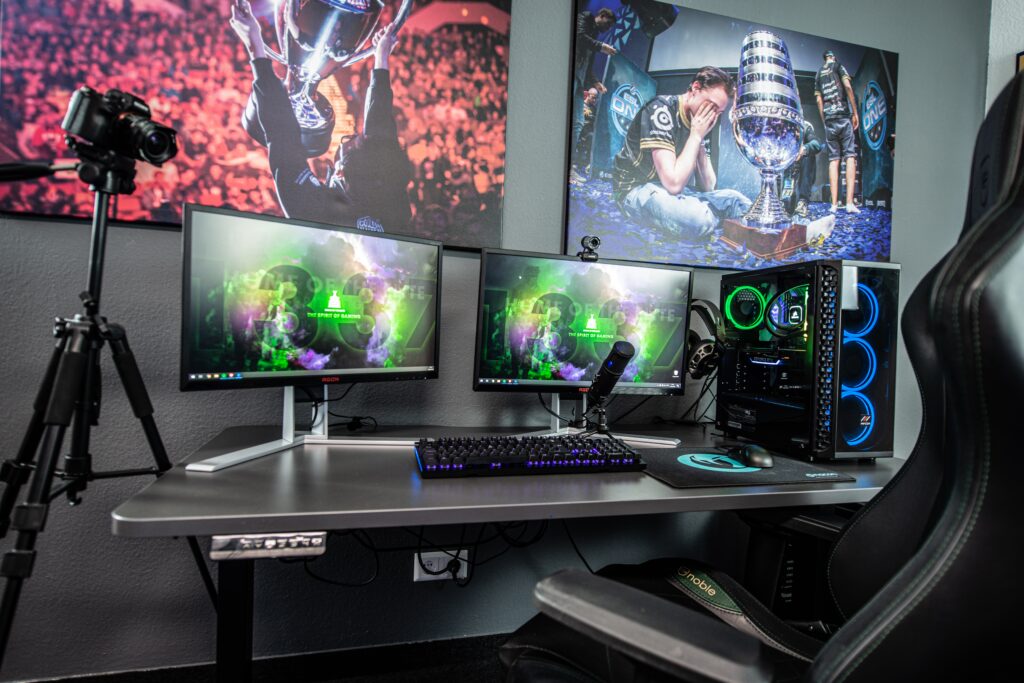Let’s talk about Metaverse statistics and market size. The Metaverse is the most recent trend that has captured the interest of major technology corporations and the rest of the world. The combination of AR (augmented reality) and VR (virtual reality) in a digital ecosystem has been dubbed the “future of the internet.”
The global Metaverse market size is predicted to skyrocket, mainly owing to the rising demand for immersive digital environments. According to Emerging Research, the Metaverse industry will be worth $828.95 billion by 2028, up from $47.69 billion in 2020. This represents a 43.3% growth in market revenue from 2021 to 2028.
Most people think of the Metaverse as a game environment where users appear as avatars and interact with the ecosystem, but it is much more than that.
The concept behind the Metaverse is the introduction of a virtual environment. This involves multifaceted interactions between people creating an immersive virtual experience. Simply put, the Metaverse is a virtual interactive ecosystem that includes everything from games to work environments, among other things.
It has acquired considerable popularity in recent years, garnering significant support from major technology corporations. The COVID-19 pandemic was crucial in gaining traction for the Metaverse.
The pandemic was a massive catalyst for the Metaverse. And resultant nature of the digital world is set to garner considerable consumer interest going forward.
The rise of NFTs and remote work has given way to the demand and need for new innovative digital solutions. These are mainly solutions that create convenient environments for making online interactions more realistic. This will undoubtedly increase Metaverse’s market size and revenue.
This article describes the Metaverse market size in detail, including market segmentation, data, and market size drivers. We’ll begin by going through an overview of the Metaverse statistics.
Key Metaverse Statistics and Market Share 2022
Here are some major Metaverse statistics that explain why it is a fascinating trend in today’s digital market.
- According to Statistica, it might reach $800 billion by 2024 from live events, advertisements, and online players, up from $46 billion in 2020.
- Online gaming and hardware will be the most significant contributions, accounting for more than $400 billion by 2024.
- Desktop and Oculus headsets dominated the market in 2021, accounting for 42.2 percent and 34.9 percent of total revenue shares, accordingly.
- Global VR/AR spending is predicted to increase from $12 billion in 2020 to $300 billion in 2024.
- International spending on VR/AR, the foundational applied sciences of the Metaverse, is expected to climb from $12 billion in 2020 to $72.8 billion in 2024.
- During the pandemic, NFTs saw a significant rise with a market share of $2.5 billion.
- According to data from Statistical, the Metaverse has a 39% chance of assisting people with disabilities.
- While the Metaverse is expected to boost creativity and thinking by 37%.
- The US accounts for a 41.2% share of the global Metaverse market, with a value estimated at $58.5 billion in 2021.
Driving Factors of the Metaverse Market Share
The rising popularity of virtual reality and augmented reality, the pandemic, and overall developments in technology (both hardware and software) are among the factors that contributed to a rise in the Metaverse market share.
COVID -19, in particular, was instrumental in driving interest in the Metaverse. Because many people began working from home, the Metaverse was a game-changer. Facebook introduced Horizon Workrooms, a meeting software for businesses that use Oculus VR headsets. It was successful in hastening the integration of virtual environments for remote working.
Furthermore, the rising demand for metaverse platforms to purchase digital assets with in-app cash and cryptocurrencies is another primary driver for the market’s rapid revenue growth. Somnium Space, for example, is a virtual reality world-building platform that enables the trade and purchase of virtual real estate.

The Metaverse is about a big trend in the digital world. We are seeing more companies and consumers integrating the Metaverse into the practices.
Additionally, we are seeing new interfaces that allow users to access 3D content via different devices such as smartphones. These are likely to drive further the Metaverse market share and revenue development. As a result, executives in blockchain, gaming, arts, retail, and healthcare are figuring out how to position themselves as key actors in this developing ecosystem.
Another major factor leading to the growth of the Metaverse market size is the increasing demand for digital assets such as NFTs and cryptocurrency. However, privacy issues, as well as cyber security breaches such as ransomware and data breaches, may have an impact on market size predictions in the future.
However, technical advancements are opening up new industry opportunities. Here is a summary of some of the main factors contributing to the Metaverse market share.
Overview of the Metaverse Statistics and Market Share
The Metaverse market is predicted to increase significantly between 2024 and 2030. According to Statistica, it might reach $800 billion by 2024 from live events, advertisements, and online players, up from $46 billion in 2020. This equals a total annual growth rate of 13.1%, according to IDC.
Online gaming and hardware will be the most prominent contributions, accounting for more than $400 billion by 2024. The Metaverse market will grow as video game developers push products into the online 3D realm that better mimic the actual world.
Plus, online game makers, including Roblox, Microsoft, Activision Blizzard, Electronic Arts, and more, boost Metaverse’s market share by integrating the 3D virtual space into their products. The remaining accounts for live entertainment such as concerts, sports events, and social media, including ads revenue.
Given the broad virtual ecosystem the Metaverse offers, we will also see a massive contribution to the market share from the digital assets. The concept of NFT will likely yield a significant contribution to the overall market share and revenue. It also is a huge factor in increasing the contribution of the gaming segment to the metaverse statistics.
In the next section, we break down the primary Metaverse market segmentations. This way, we can better understand the metaverse market share and statistics.
Metaverse Market Share Segmentations
The Metaverse market is divided into platform, application, component, and end-user segments. The market size is further divided into hardware and software based on the component.
On the other hand, the platform comprises desktop, mobile, and headphones. Technology is the most significant market segment divided into the blockchain, VR & AR, mixed reality, and others. The application market is segmented into gaming, commerce, content creation, social media, etc.
The market has been divided into two categories in terms of end-users: consumers and enterprises. Engineering, BFSI, media & entertainment, retail, education, aerospace & defense, real estate, healthcare, etc. are some of the sectors the enterprise is divided into. Here is a more detailed breakdown of the top contributors to the Metaverse market share.
Metaverse Statistics and Market Share by Component and Technology
Overall, gaming hardware and software, including gaming PCs and peripherals and AR/VR hardware such as Facebook’s Oculus, accounted for the largest Metaverse market share in 2020.
Overview of Components and Technologies of the Metaverse
Hardware segmentation includes displays, AR, MR, and VR Products. The hardware segment accounted for the largest market share in 2021, owing to the increase in the use of AR. MR and VR devices.
Desktop and Oculus headsets dominated the market in 2021, accounting for 42.2% and 34.9% of total revenue shares, accordingly. Furthermore, they are expected to remain the most significant revenue-generating technology components for the next few years.
The VR and AR technology sector held the largest revenue share in terms of hardware components in 2021. The main driving factor was the increasing application of AR and VR in multiple industries such as gaming, healthcare, education, and entertainment.

Which have progressively embraced VR and AR technology for a variety of applications. AR and VR devices are also finding their way into the human resources division. With devices being used to facilitate staff training.
The debut of Facebook workrooms was a novel and dynamic method to organize meetings and engage with each other through VR utilizing Oculus headsets. It has raised Oculus headset demand and market share. In terms of individual hardware components, Oculus headsets currently contribute the most percentage of the market share in 2021.
Some companies have even created advanced VR headsets that enhance the lifelikeness of the real world. People will quickly realize that they need VR and AR equipment to fully immerse themselves in the Metaverse.
Metaverse Market share Statistics based on Technology and Components
Global VR/AR spending is predicted to increase from $12 billion in 2020 to $300 billion in 2024. While VR technologies are expected to reach $10 billion in users by the end of the year. On the other hand, AR technologies are expected to reach $1.1 billion.
Global exports of VR and AR are estimated to reach 76 million by 2024 as more individuals invest in Metaverse technologies. By 2023, 26 million units are estimated to be sold due to rising demand.
International spending on VR/AR, the foundational applied sciences of the Metaverse, is expected to climb from $12 billion in 2020 to $72.8 billion in 2024. As a result, innovators in gaming, retail, arts, healthcare, and blockchain are figuring out how to position themselves as key players in this emerging ecosystem.
While CCS Insight predicts that mixed reality headset sales will increase from 22 million in 2018 to 121 million by the end of 2022.
Metaverse Statistics and Market Share by Application
The gaming sector is estimated to dominate the Metaverse in terms of application. While the ads and social media segment is anticipated to witness considerable growth over 2020 – 2028 owing to the increased demand for social media applications and Meta.
The software sector is likely to display a considerably swift revenue CAGR through the projected period. Because companies will start investing considerable efforts into developing developer-focused gaming platforms.
Which will enable users to create games or 3D environments. AI-powered 3D engines allow for real-time gaming content development, allowing for a wide diversity of scenarios and making games more interesting.
Gaming
Gaming is one of the first Metaverse integrations as gamers create their worlds. Because the Metaverse offers a realistic virtual experience, it is a natural stepping stone for the gaming industry. The Metaverse can help increase game engagement, virility, and revenue.

The primary revenue from the gaming industry consists mainly of gaming software, hardware, and services. Robust investments from gaming companies also form a large percentage of the gaming industry’s Metaverse market contribution.
For example, epic Games raised $1 billion in April 2021 to accelerate the long-term vision of the Metaverse. In addition, Roblox contributed a large percentage to the growth and expansion of gaming in the Metaverse. This is one of the most popular gaming companies in the Metaverse, with over 47 million daily active users.
Within this market size, there is an estimated revenue of $412.9 billion in 2024 vs. $214.9 in 2020. The gaming industry also accounts for more than 50% of the total market size of the Metaverse.
NFT and Cryptocurrency
During the pandemic, NFTs saw a significant rise. With a market share of $2.5 billion. The use of the Metaverse for cryptocurrency trading has gained steady traction worldwide.
Blockchain-based virtual reality platforms like Decentraland raised $24 million before its initial launch in February 2020.
Decentraland, similar to second life and Minecraft, allows users to buy non-fungible plots of digital land. This can then be monetized through decentralized games and apps.
In the first three months after the release, Decrentraland earned $7.5 million. Accounting for less than 10% of the NFT’s market share.
The cryptocurrency of the Roblox platform also seems to be gaining traction. This is why people spent more than $652 million on virtual currency.
Live Events
Live shows in the Metaverse, such as concerts and sports, provide an additional, ever-expanding Metaverse market size. For instance, a spectacular virtual concert was hosted on the Fortnite platform that streamed to over 12 million people. They created a complete Metaverse concert for fans to attend. Which allowed fans to engage with artists such as Ariana Grande and Travis Scott.
Fans could approach and even interact with the artists’ avatars during these immersive virtual concerts. And they could even buy concert merch, exactly like at a live show.
Gucci also partnered with Roblox to create a virtual Gucci Garden. Limited-edition Gucci items, such as handbags and accessories, were sold in this virtual realm.
In January 2022, Sandbox also launched a joint venture with Warner Music Group. The ultimate goal is to create one of the first music-themed ecosystems in The Sandbox Metaverse. With this partnership, Warner Music Group would be taking a massive step into the Metaverse market.
Revenue from live events that are part of the Metaverse may exceed $200 billion in 2024. According to research from Statistica, the market size is likely to expand as live hosting providers progressively recover from the pandemic.
Fashion
Before we go any further, here are some general fashion sector insights. In 2019, the global fashion sector generated 1.9 trillion dollars in sales. It is estimated that 3 trillion will be spent by 2030.
Despite the pandemic, fashion continues to thrive. It has increased significantly in certain regions, such as Asia-Pacific and Europe. Joining the Metaverse is projected to triple the fashion industry’s metrics in the coming years.
The fashion industry is likely to contribute significantly to the metaverse market share in terms of revenue. Digital fashion demand, in particular, is predicted to add $50 billion to the metaverse market share by 2030.
The metaverse fashion industry is drastically changing from big retail companies collaborating with an online network of artists to purchasing avatar clothing. Not only that, many retail companies see the Metaverse’s enormous potential as a critical marketing channel.
For example, Animal Crossing, a Nintendo Co. Ltd. game, has leaped into the Metaverse industry. They’ve teamed with brands like Anna Sui to create metaverse-specific clothes.

Metaverse Statistics and Market Share by Consumer Value
There is no doubt that the Metaverse is here to stay. According to data from Statistical, it has a 39% chance of assisting people with disabilities. While the Metaverse is expected to boost creativity and thinking by 37%.
Even with the Metaverse’s potential benefits, some people are still hesitant to join this emerging movement. According to Metaverse statistics, in 2021, % of adults in the United States will be uninterested in joining or using the Metaverse.
Despite these data, 83.7 million Americans used at least one component of the Metaverse. Most notably AR, at least once a month in 2020. By 2023, this figure is predicted to rise to 110 million.
Metaverse Statistics and Market Share by Region
The global metaverse market is divided into five primary regions based on geographical analysis: North America, Europe, Asia Pacific, Latin America, and the Middle East and Africa.
Due to various factors, North America accounts for the most significant Metaverse market size contribution. This includes the rise of technology start-up companies and the increasing demand for digital virtual experiences.
Furthermore, the growing interest in integrating the Metaverse platform into industries like education and gaming has expanded Metaverse adoption in North America. Along with the usage of the Metaverse in education, various entertainment, multimedia, and marketing companies are investing in it.
For example, there have been significant investments by companies such as Meta, Epic Games, and Nextech AR solutions. This will raise the Metaverse market share of North America, specifically in the US and Canada.
Whist North America has the largest Metaverse market size, the Asia Pacific is expected to witness the fastest growth in the global Metaverse market. This is because Metaverse platforms are increasingly integrated into the entertainment and gaming industries.
With huge Metaverse investments and development in countries like Thailand, China, Japan, and South Korea, the Asia Pacific Metaverse market is expected to grow significantly. Plus, the growing popularity of people shifting towards the virtual reality world is substantial.
The Metaverse market in Europe is expected to see steady growth in revenue CACR over 2020 – 2028. Expansion of the gaming industry is a critical driver in the growing popularity of the Metaverse revenue and market share in Europe.
The Metaverse concept is gaining more attention owing to the increasing number of gamers. Facebook announced in 2021 that it will be hiring 10,000 workers in Europe to help with the expansion of the Metaverse. This initiative will also allow the company access to the largest Metaverse consumer marketplace.
Metaverse Statistics and Market Share by Country
Some of the key countries contributing to the surge in the market are the US, U.K., Germany, France, China, India, Japan, and South Korea.
The US accounts for a 41.2% share of the global Metaverse market, with a value estimated at $58.5 billion in 2021.
China is expected to reach a Metaverse market share of $103.1 billion by 2024, with a CAGR of 38.1% through the forecasted period. The countries with the most significant Metaverse market share include Japan and Canada, each expected to have a market share of 31.9% and 29.6%, respectively, over the forecasted period.
Another significant Metaverse market share, Seoul, revealed a five-year plan to transform the country into “Metaverse Seoul”. Through the Metaverse, users in the country will attend events and visit tourism attractions.
China’s most prominent technology businesses, such as Alibaba and Tencent, are expanding their digital features to include features of the Metaverse.
Germany will lag with a 36.8 % CAGR of the Metaverse market share in European countries. By 2024, the rest of Europe will have a combined Metaverse revenue of $59.5 billion.
The Bottom Line
Many people predict that 2022 will be the biggest year for the Metaverse market share and revenue. In addition, the increased use of the Metaverse for purchasing digital assets such as NFTs and cryptocurrency is expected to drive market expansion.
Companies like Epix, Roblox, and Meta have already invested in the Metaverse. While industry segments like remote work, gaming, exercise, and socializing are expected to expand in the metaverse scene.
This growing integration of the Metaverse into various industries will likely result in tremendous growth. 2022 will also see more fashion brands move into the metaverse scene, accelerating their growth within this new virtual space.
As per the geographic analysis, North America, Europe, and the Asia Pacific will be the most significant contributors to the Metaverse. The North American market is expected to generate a significant percentage of the $800,000 Metaverse market revenue.
Data from the World Bank suggests that 2.833% of the total GDP was already spent on some sort of Metaverse components. In addition, the presence of major companies in North America will boost the Metaverse market share.
It goes without saying there are still many uncertainties with the Metaverse. But one thing is for sure it is limitless, allowing companies to create and design new technologies.



